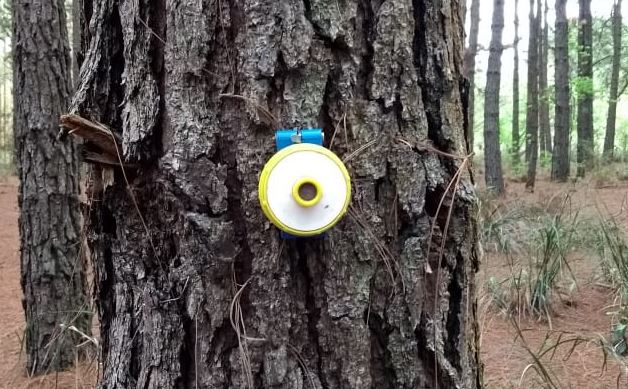Hipsometric equations for Pinus sp. at the Itatinga forest sciences experimental station, São Paulo
DOI:
https://doi.org/10.20873/jbb.uft.cemaf.v8n4.senaKeywords:
total height, forest management, forest inventoryAbstract
Among the forest essences cultivated in Brazil, the species of the genus Pinus stand out, presenting a great concentration in the South region of the country, with the most cultivated species being Pinus elliottii and Pinus taeda. The objective of this work was to adjust mathematical equations to estimate the height of trees in stands of Pinus taeda L, Pinus oocarpa and hybrid Pinus (Pinus oocarpa x Pinus caribaea var. Hondurensis), at the Experimental Forest Science Station in Itatinga - São Paulo. For this, a stratified and systematic forest inventory by age (21, 22 and 24 years) was carried out, using systematic sampling of 3 plots per area. Each plot consisted of 90 trees from which all diameters were measured at 1.30 m from the ground (DBH) and the total heights of the first 15 trees of each plot were measured in order to cover all classes of the stand. For the adjustment, 10 hypsometric equations were tested, being selected according to the values of adjusted determination coefficient (R2aj), residual standard error (Syx%), variation coefficient (CV%), F and residual graphical analysis. The best equation adjusted to describe the h / d ratio for the species Pinus taeda, Pinus oocarpa and hybrid Pinus (Pinus oocarpa x Pinus caribaea var. Hondurensis) at all ages was that of Prodan.
References
Artes R, Coeficiente de assimetria. Insper, 11p. 2014.
Associação Brasileira de Florestas - ABRAF. Anuário estatís-tico da ABRAF 2012: Ano base 2011.7ª Ed., Brasília, 2012.
Atanazio KA, Kreft SM, Vuaden AL, Kein DR, Oliveira GS, Silva MTS. Comparação de modelos para relação hipsomé-trica em florestas de Pinus taeada L. no município de Enéas Marques, Paraná. Scientia Agraria Paranaensis, v. 16, n. 4, p. 535-541, 2017. http://dx.doi.org/10.18188/1983-1471/sap.v16n4p535-541.
Bartoszeck ACPS, Machado AS, Oliveira EB. A distribuição diamétrica para bracatingais em diferentes idades, sítios e densidades na região metropolitana de Curitiba. Revista Floresta. 2004 Set/Dez; 34(3):305-323. http://dx.doi.org/0.5380/rf.v34i3.2418.
Brum BNS. Estratégias de ajustes de modelos hipsométricos para povoamentos de Tectona spp. Ano de obtenção: 2015, 30p. Trabalho de conclusão de curso (Graduação em Enge-nharia Florestal) – Universidade Federal do Mato Grosso. Cuiabá.
Cohen J. Statistical power analysis for the behavioral sciences. Hillsdale: Lawrence Erlbaum Associates Publishers; 1988. 567p.
Donadoni AX, Pelissari AL, Drescher R, Rosa GD. Relação hipsométrica para Pinus caribaea var. hondurensis e Pinus tecunumanii em povoamento homogêneo no Estado de Rondônia. Ciência Rural, v.40, n.12, p.2499-2504, 2010. https://doi.org/10.1590/S0103-84782010001200010.
ESALQ, Estação Experimental de Ciências Florestais – Itatin-ga, 2014. Disponível em:< http://www.esalq.usp.br/svee/lcf-itatinga>. Acesso em: 26 de out. de 2020.
ESALQ, Serviços de Estações Experimentais, 2016. Disponí-vel em:< http://www.esalq.usp.br/svee/Itatinga/itatinga_area.htm>. Acesso em: 26 de out. de 2020.
Figueiredo R, Nascimento FAF, Filho AF, Miranda GM, Arce JE, Dias AN. Comparação de modelos para expressar a relação hipsométrica em plantios de Pinus taeda L. In: SEMANA DE INTEGRAÇÃO ENSINO, PESQUISA E EXTENSÃO, 1., 2009, Irati, PR. Anais eletrônico... Irati, Paraná, 2009.
Filho,DF; Nunes,F; Rocha,EC da;Santos,ML; Batis-tia,M;Júnior,JAS. O que Fazer e o que Não Fazer com a Regressão: pressupostos e aplicações do modelo linear de Mínimos Quadrados Ordinários (MQO). Revista Política Hoje, Vol. 20, n. 1, 2011. https://doi.org/10.7910/DVN/LU5U7H.
Finger CAG. Fundamentos da biometria florestal. Santa Ma-ria: UFSM/CEPEF/FATEC, 314p. 2006.
Gomes SS. Predição da Disponibilidade de nitrogênio poten-cial de resposta à fertilização nitrogenada em plantações de eucalipto. Tese (Doutorado em Recursos Florestais, com opção em Silvicultura e Manejo Florestal) – Universidade de São Paulo, Piracicaba, 2009.
Guedes TA, Martins ABT, Arcosi LRC, Janeiro V. Projeto de ensino aprender fazendo estatística. Universidade Estadual de Maringá, 49p, 2005.
Indústria Brasileira de Árvores - IBÁ. Relatório Anual de 2019: Report 2019. 8a. Ed., Brasil. 2019.
Instituto Brasileiro de Geografia e Estatística – IBGE. Biomas e sistema costeiro-marinho do Brasil: compatível com a es-cala 1:250 000, Rio de Janeiro, RJ: IBGE, 2019.
Jesus CM, Miguel EP, Azevedo GB; Azevedo GTOS, Pereira RS. Modelagem hipsométrica em povoamento clonal de Eu-calyptus urophylla x Eucalyptus grandis no Distrito Fede-ral. Enciclopédia Biosfera, v.11, n.21, p.1298-1308, 2015. https://doi.org/10.30612/agrarian.v11i40.3324.
Pimentel-Gomes F. Curso de estatística experimental. 15. ed. Piracicaba: Fealq, p. 451, 2009.
Sette Junior CR, Tomazello Filho M, Dias CTS, Laclau JP. Crescimento em diâmetro do tronco das árvores de Eucalyp-tus grandis W. Hill. ex. Maiden e relação com as variáveis climáticas e fertilização mineral. Revista Árvore, v. 34, n. 6, p. 979-990, 2010. https://doi.org/10.1590/S0100-67622010000600003.
Sousa GTO, Azevedo GB, Barreto PAB, Júnior VC. Relações hipsométricas para Eucalyptus urophylla conduzidos sob regime de alto fuste e talhadia no Sudoeste da Bahia. Scien-tia Plena, v.9, n.4, p.1-7, 2013

Downloads
Published
How to Cite
Issue
Section
License
Copyright (c) 2024 - Journal of Biotechnology and Biodiversity

This work is licensed under a Creative Commons Attribution 4.0 International License.
Authors who publish with this journal agree to the following terms:
Authors retain copyright and grant the journal right of first publication with the work simultaneously licensed under a Creative Commons Attribution License (CC BY 4.0 at http://creativecommons.org/licenses/by/4.0/) that allows others to share the work with an acknowledgement of the work's authorship and initial publication in this journal.
Authors are able to enter into separate, additional contractual arrangements for the non-exclusive distribution of the journal's published version of the work (e.g., post it to an institutional repository or publish it in a book), with an acknowledgement of its initial publication in this journal.
Authors are permitted and encouraged to post their work online (e.g. in institutional repositories or on their website) prior to and during the submission process, as it can lead to productive exchanges, as well as earlier and greater citation of published work (Available at The Effect of Open Access, at http://opcit.eprints.org/oacitation-biblio.html).


